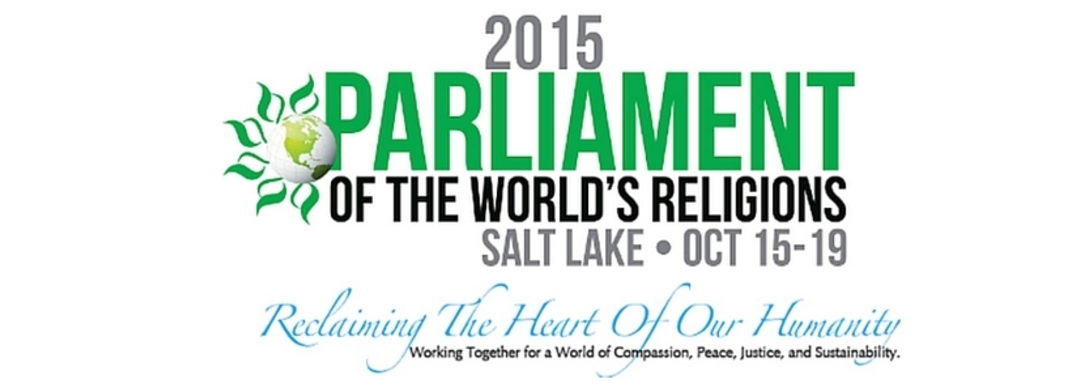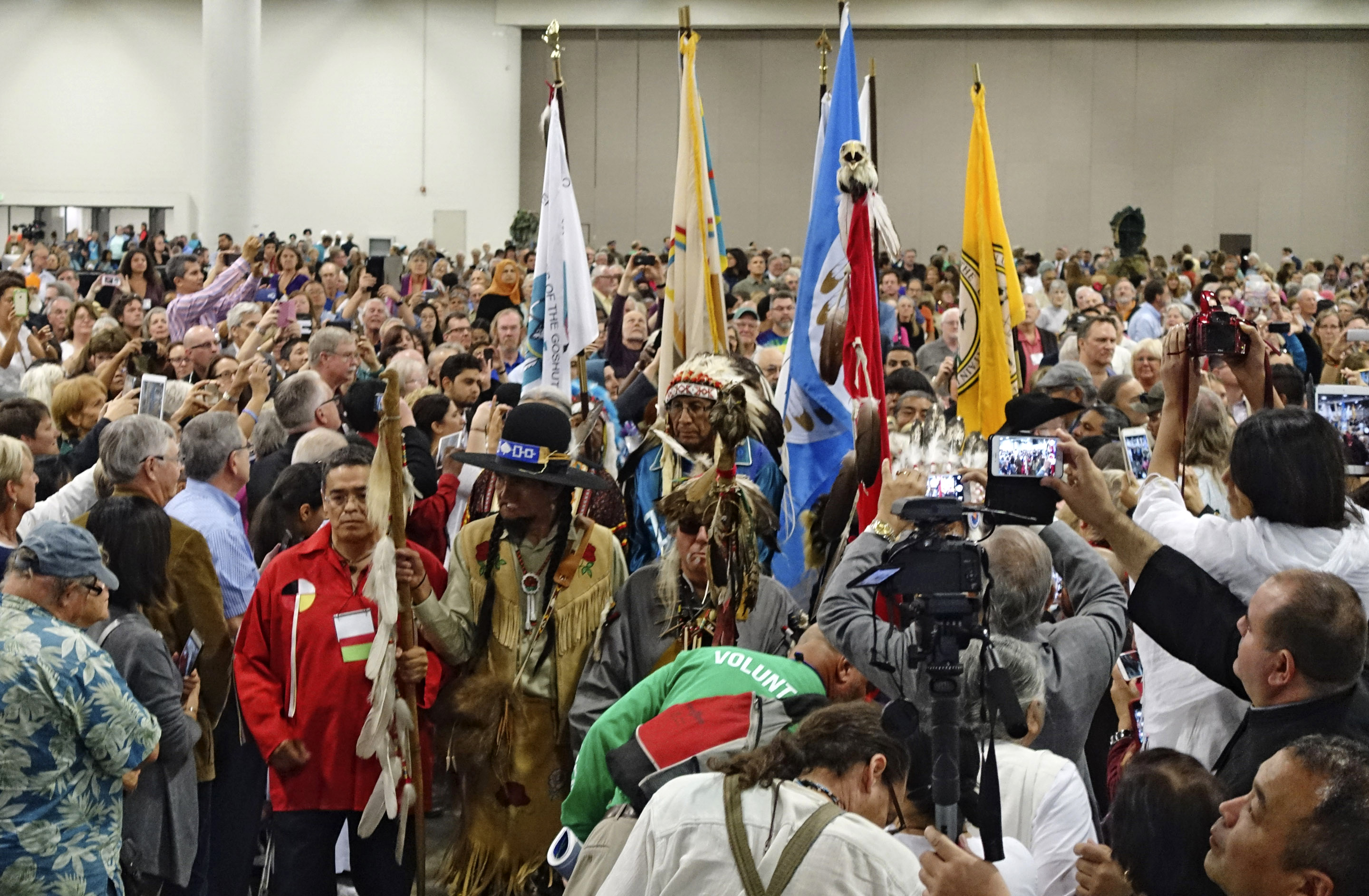 |
| LA Parliament folks: Deb and Andre Van Zyl, Shanae Diaz, Jeff Utter, Rev Prof Rose, Thomas Hedberg |
 Paul Nugent felt that overall the Parliament was a wonderful experience but it was not without shortcomings, such as having eight men in suits on stage during the opening session (there was a general consensus this was a bad move). He pointed out that the "global" Parliament was largely English-speaking and mostly American. What he especially liked was the Langar (free lunch) that the Sikhs provided each day for thousands of participants as a religious service.
Paul Nugent felt that overall the Parliament was a wonderful experience but it was not without shortcomings, such as having eight men in suits on stage during the opening session (there was a general consensus this was a bad move). He pointed out that the "global" Parliament was largely English-speaking and mostly American. What he especially liked was the Langar (free lunch) that the Sikhs provided each day for thousands of participants as a religious service.
Jeff Utter has attended four Parliaments and observed that the interfaith movement has finally "arrived" and become more widely accepted. He appreciated the various people he encountered and noted how "perplexingly different" people are. He concluded by saying, "I wish a Parliament experience for all of you."
Dick Bunce had a carefully prepared reflection in which he discussed the "new interfaith great awakening" and how perplexingly difficult it was to find one's way around the Salt Palace, opining that it may have been designed by an inebriated architect. I hope to publish Dick's thoughtful and witty reflection in a later blog. I'm afraid I wouldn't do it justice by paraphrasing it here.
Stephen Longfellow Fiske spoke passionately about the need for a "revolution of consciousness that sees beyond the walls of separation and religion. That's what the Parliament was about, and what we need to cultivate. It was inspiring to be among brothers and sisters who share that consciousness. How do we magnify that consciouness and share it with the rest of the world?"
John Ishvaradas Abdullah enjoyed the Parliament and took innumerable pictures of himself with his amazingly diverse array of friends (he is often seen wearing a Sikh turban he donned for this occasion, which the Sikhs provided along with a free lunch). However, John was disturbed that the Imam of Mecca was invited to speak at a plenary session since this spiritual leader is complicit with the many human rights abuses perpetrated by Saudi Arabia. John wrote the following letter in response to the Parliament's self-congratulatory announcement about the grand imam of Mecca.
"GRAND IMAM OF MECCA AT THE PARLIAMENTThis is another first for the Parliament. It is the first time ever that a grand Imam of Mecca will deliver a keynote for the Parliament. It is yet another sign of the growing interfaith movement around the world. The Grand Imam of the holiest mosque of Mecca, Sheikh Saleh Abdullah bin Humaid, has confirmed to be a keynoter at the 2015 Parliament.In the past he has served as the head of all Imams and khateebs of Masjid al-Haram in Makkah, Saudi Arabia. He has also served as chair of the Saudi Arab Parliament called Majlis AsShura."* * * * * * * * *I am deeply troubled by this announcement ... Are we, at the Parliament, rewarding Saudi Arabia for its dismal Human Rights record? ... Its horrible record of discrimination of faith traditions other than that of the so-called Royal family? Its glorification of public hangings and beheadings? ... Its glorification of disparity of wealth and gender inequality? ... And the list is quite long ...I want to know why this so-called Grand Imam has been invited? And who was involved in the process of inviting him?I would like to raise these questions at the Parliament and invite you to join me ... Thank you ... With love and best wishes, always ...[Please also see on my timeline, the Petition I signed to remove Saudi Arabia from the UN Human Rights Commission and consider signing it if you have not done so already.]
 |
| Shiva |
Anna Crews Camphouse shared her delight that women played such an important role in the Parliament and spoke of her enthusiasm for the interfaith movement. She has a passionate concern for environmentalism and also attended the Conference "Seizing an Alternative: Towards an Ecological Civilization" that took place in June in Claremont. This Conference was sponsored in part by an environmental group called "Pando Populus," named after a grove of aspen in Utah that is the oldest living creature on earth, nearly 60,000 years old. Camphouse went to see this grove with her friend Bonnie Tarwater, a minister of the church of Mary Magdalene. (I remarked how interconnected we all are, like the roots of Pando Populus: I met Bonnie for the first time at the Parliaent and considered going with this group to see this ancient grove of aspen.)
Lastly, I gave a summary of my experiences at the Parliament, which I have reprinted below.
Afterwards, we had a lively but far too short time of discussion and q and a. We decided to schedule a follow up meeting with Ruth Sharone and Joseph Prabhu when he returns from his teaching stint in Oxford sometime in December.
Afterwards, we had a lively but far too short time of discussion and q and a. We decided to schedule a follow up meeting with Ruth Sharone and Joseph Prabhu when he returns from his teaching stint in Oxford sometime in December.
A Quaker Perspective on the 2015 Parliament of the World's Religions
As a Quaker, I try to find a balance between contemplation and action. I take to heart the words of William Penn, “True godliness does not turn men out of the world, but enables them to live better in it and excites their endeavors to mend it.”
During the five days of the Parliament, there was plenty to satisfy the need both for contemplation and for activism. Dozens of religious groups led times of worship, meditation sessions, sacred songs and dances (such as the whirling dervishes), and sacred arts (such as the beautiful sand mandalas of the Tibetan Buddhists). There were also booths with intellectually stimulating books on topics ranging from theology to ecology, from ending war to the spirituality of gardening. Various religious groups led workshops, including my tribe, the Quakers.
 |
| Quakers at Sikh Langar |
The plenaries focused on the major concerns of our time: women’s issues; emerging leaders; income inequality; war, violence and hate speech; the climate crisis; and indigenous peoples.
There were hundreds of workshops led by over 1200 presenters. There were so many that it was often agonizingly difficult to choose. Here are the workshops that I was drawn to.
 |
| Indians at Promised Land workshop |
2) Ending homelessness. I went to a workshop which featured Pamela Atchinson, a woman from Utah who has been a key figure in ending homelessness. I loved this woman and her spirit. She cares deeply about homeless people, knows many of them as friends, and is committed to ending homelessness in her state. Using the Housing First model, and Rapid Rehousing, Utah has reduced its chronically homeless population 90%, from 2000 to a couple of hundred. And there are no chronically homeless vets in Salt Lake City! I wish I had time to tell you more about Pamela Atchinson. Like Jill, she’s one of my heroes
 |
| Women's Plenary "Sheroes" dancing |
 |
| Rev Ignacio Casuera |
4) The prophetic power of women. I was inspired and challenged by the powerful women at this session: Kathy Kelly, Rabbi Lynn Gottlieb, Vandana Shiva, Marianne Williamson, Grandmother Mary Lyons, Karen Armstrong, et al. I wish I had time to share with you the powerful messages that these women conveyed.
5) I was also impressed by a workshop in which Karen Armstrong, Rabbi Lynn Gottlieb, and Professor Jonathan Brown dealt with what they called “texts of terror” in the Torah, the Christian Gospel and the Quran. This is a topic that Joseph Prabhu invites us to explore: what is the relationship between violence and religion?
 |
| Pastor will Barber |
This “altar call” was the spiritual highpoint of the Gathering for me, and also for David Hartsough and Eisha Mason. David wants Will Barber to light a fire under the Quakers, and Eisha Mason wants him to light a fire under the AFSC. And I’d like Barber to come out here to light a fire here in LA. We need prophetic fire! Thanks to my wife, and to Evangelical leaders like Will Barber and Jim Wallis (who was also at the Parliament), I have come to appreciate more and more how Evangelicals touch the heart and transform lives through their inspired preaching.
Finally, the Gathering gave us not only inspiration, but also homework. We were given something called “The Commitment Book.” It contains a call to action from the Dalai Lama and declarations of action on each of the issue areas, from income inequality to climate change and indigenous rights, and it provides space in which to write down our resolve and commitments. As a Quaker, I applaud the Parliament for encouraging us to put our spirituality into action. I hope that the spirit of the Parliament inspires and challenges all of us to redouble our efforts to make this world a more peaceful and just place.
 |
| Debra and Andre Van Zyl at their art booth |
 |
| Eisha Mason |
 |
| Jay Marshall, Dean of the Earlham School of Religion |
 |
| Michael Birkel, Quaker scholar |













